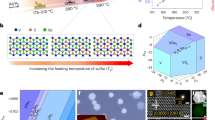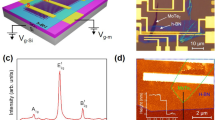Abstract
Doping is required to modulate the electrical properties of semiconductors but introduces impurities that lead to Coulomb scattering, which hampers charge transport. Such scattering is a particular issue in two-dimensional semiconductors because charged impurities are in close proximity to the atomically thin channel. Here we report the remote modulation doping of a two-dimensional transistor that consists of a band-modulated tungsten diselenide/hexagonal boron nitride/molybdenum disulfide heterostructure. The underlying molybdenum disulfide channel is remotely doped via controlled charge transfer from dopants on the tungsten diselenide surface. The modulation-doped device exhibits two-dimensional-confined charge transport and the suppression of impurity scattering, shown by increasing mobility with decreasing temperature. Our molybdenum disulfide modulation-doped field-effect transistors exhibit a room-temperature mobility of 60 cm2 V–1 s–1; in comparison, transistors that have been directly doped exhibit a mobility of 35 cm2 V–1 s–1.
This is a preview of subscription content, access via your institution
Access options
Access Nature and 54 other Nature Portfolio journals
Get Nature+, our best-value online-access subscription
$29.99 / 30 days
cancel any time
Subscribe to this journal
Receive 12 digital issues and online access to articles
$119.00 per year
only $9.92 per issue
Buy this article
- Purchase on Springer Link
- Instant access to full article PDF
Prices may be subject to local taxes which are calculated during checkout




Similar content being viewed by others
Data availability
The data that support the findings of this study are available from the corresponding authors upon reasonable request.
References
Shi, W. et al. Reversible writing of high-mobility and high-carrier-density doping patterns in two-dimensional van der Waals heterostructures. Nat. Electron. 3, 99–105 (2020).
Lee, S.-J., Lin, Z., Duan, X. & Huang, Y. Doping on demand in 2D devices. Nat. Electron. 3, 77–78 (2020).
Dillen, D. C., Kim, K., Liu, E.-S. & Tutuc, E. Radial modulation doping in core–shell nanowires. Nat. Nanotechnol. 9, 116–120 (2014).
Chen, Y. Z. et al. Extreme mobility enhancement of two-dimensional electron gases at oxide interfaces by charge-transfer-induced modulation doping. Nat. Mater. 14, 801–806 (2015).
Lee, H. et al. Direct observation of a two-dimensional hole gas at oxide interfaces. Nat. Mater. 17, 231–236 (2018).
Dingle, R., Störmer, H. L., Gossard, A. C. & Wiegmann, W. Electron mobilities in modulation‐doped semiconductor heterojunction superlattices. Appl. Phys. Lett. 33, 665–667 (1978).
Khan, M. A., Hove, J. M. V., Kuznia, J. N. & Olson, D. T. High electron mobility GaN/AlxGa1−xN heterostructures grown by low‐pressure metalorganic chemical vapor deposition. Appl. Phys. Lett. 58, 2408–2410 (1991).
Tsui, D. C., Stormer, H. L. & Gossard, A. C. Two-dimensional magnetotransport in the extreme quantum limit. Phys. Rev. Lett. 48, 1559–1562 (1982).
Nelson, S. F. et al. Observation of the fractional quantum Hall effect in Si/SiGe heterostructures. Appl. Phys. Lett. 61, 64–66 (1992).
Chhowalla, M., Jena, D. & Zhang, H. Two-dimensional semiconductors for transistors. Nat. Rev. Mater. 1, 16052 (2016).
Akinwande, D. et al. Graphene and two-dimensional materials for silicon technology. Nature 573, 507–518 (2019).
Lee, D. et al. Self-powered chemical sensing driven by graphene-based photovoltaic heterojunctions with chemically tunable built-in potentials. Small 15, 1804303 (2019).
Lee, C.-H. et al. Atomically thin p–n junctions with van der Waals heterointerfaces. Nat. Nanotechnol. 9, 676–681 (2014).
Ye, J. T. et al. Superconducting dome in a gate-tuned band insulator. Science 338, 1193–1196 (2012).
Ma, N. & Jena, D. Charge scattering and mobility in atomically thin semiconductors. Phys. Rev. X 4, 011043 (2014).
Li, S.-L., Tsukagoshi, K., Orgiu, E. & Samorì, P. Charge transport and mobility engineering in two-dimensional transition metal chalcogenide semiconductors. Chem. Soc. Rev. 45, 118–151 (2016).
Kang, S. et al. 2D semiconducting materials for electronic and optoelectronic applications: potential and challenge. 2D Mater. 7, 022003 (2020).
Shi, Q. et al. Odd- and even-denominator fractional quantum Hall states in monolayer WSe2. Nat. Nanotechnol. 15, 569–573 (2020).
Hunt, B. et al. Massive Dirac fermions and Hofstadter butterfly in a van der Waals heterostructure. Science 340, 1427–1140 (2013).
Dean, C. R. et al. Hofstadter’s butterfly and the fractal quantum Hall effect in moiré superlattices. Nature 497, 598–602 (2013).
Zeng, H., Dai, J., Yao, W., Xiao, D. & Cui, X. Valley polarization in MoS2 monolayers by optical pumping. Nat. Nanotechnol. 7, 490–493 (2012).
Mak, K. F., McGill, K. L., Park, J. & McEuen, P. L. The valley Hall effect in MoS2 transistors. Science 344, 1489–1492 (2014).
Lee, J., Mak, K. F. & Shan, J. Electrical control of the valley Hall effect in bilayer MoS2 transistors. Nat. Nanotechnol. 11, 421–425 (2016).
Lu, X. et al. Superconductors, orbital magnets and correlated states in magic-angle bilayer graphene. Nature 574, 653–657 (2019).
Cao, Y. et al. Unconventional superconductivity in magic-angle graphene superlattices. Nature 556, 43–50 (2018).
Tran, K. et al. Evidence for moiré excitons in van der Waals heterostructures. Nature 567, 71–75 (2019).
Jin, C. et al. Observation of moiré excitons in WSe2/WS2 heterostructure superlattices. Nature 567, 76–80 (2019).
Cui, X. et al. Multi-terminal transport measurements of MoS2 using a van der Waals heterostructure device platform. Nat. Nanotechnol. 10, 534–540 (2015).
Liu, Y. et al. Approaching the Schottky–Mott limit in van der Waals metal–semiconductor junctions. Nature 557, 696–700 (2018).
Liu, Y. et al. Toward barrier free contact to molybdenum disulfide using graphene electrodes. Nano Lett. 15, 3030–3034 (2015).
Yu, Z. et al. Realization of room-temperature phonon-limited carrier transport in monolayer MoS2 by dielectric and carrier screening. Adv. Mater. 28, 547–552 (2016).
Kiriya, D., Tosun, M., Zhao, P., Kang, J. S. & Javey, A. Air-stable surface charge transfer doping of MoS2 by benzyl viologen. J. Am. Chem. Soc. 136, 7853–7856 (2014).
Lim, D. et al. High performance MoS2-based field-effect transistor enabled by hydrazine doping. Nanotechnology 27, 225201 (2016).
Jo, S.-H. et al. A high-performance WSe2/h-BN photodetector using a triphenylphosphine (PPh3)-based n-doping technique. Adv. Mater. 28, 4824–4831 (2016).
Li, H.-M. et al. Ultimate thin vertical p–n junction composed of two-dimensional layered molybdenum disulfide. Nat. Commun. 6, 6564 (2015).
Schmidt, H., Giustiniano, F. & Eda, G. Electronic transport properties of transition metal dichalcogenide field-effect devices: surface and interface effects. Chem. Soc. Rev. 44, 7715–7736 (2015).
Zhao, Y. et al. Doping, contact and interface engineering of two-dimensional layered transition metal dichalcogenides transistors. Adv. Funct. Mater. 27, 1603484 (2017).
Li, S.-L. et al. Thickness scaling effect on interfacial barrier and electrical contact to two-dimensional MoS2 layers. ACS Nano 8, 12836–12842 (2014).
Simon, J., Protasenko, V., Lian, C., Xing, H. & Jena, D. Polarization-induced hole doping in wide–band-gap uniaxial semiconductor heterostructures. Science 327, 60–64 (2010).
Lee, I. et al. Gate-tunable hole and electron carrier transport in atomically thin dual-channel WSe2/MoS2 heterostructure for ambipolar field-effect transistors. Adv. Mater. 28, 9519–9525 (2016).
Song, S. et al. Wafer-scale production of patterned transition metal ditelluride layers for two-dimensional metal–semiconductor contacts at the Schottky–Mott limit. Nat. Electron. 3, 207–215 (2020).
Allain, A., Kang, J., Banerjee, K. & Kis, A. Electrical contacts to two-dimensional semiconductors. Nat. Mater. 14, 1195–1205 (2015).
Zheng, X. et al. Patterning metal contacts on monolayer MoS2 with vanishing Schottky barriers using thermal nanolithography. Nat. Electron. 2, 17–25 (2019).
Gurvitch, M. Ioffe-Regel criterion and resistivity of metals. Phys. Rev. B 24, 7404–7407 (1981).
Radisavljevic, B. & Kis, A. Mobility engineering and a metal–insulator transition in monolayer MoS2. Nat. Mater. 12, 815–820 (2013).
Kaasbjerg, K., Thygesen, K. S. & Jacobsen, K. W. Phonon-limited mobility in n-type single-layer MoS2 from first principles. Phys. Rev. B 85, 115317 (2012).
Fivaz, R. & Mooser, E. Mobility of charge carriers in semiconducting layer structures. Phys. Rev. 163, 743–755 (1967).
Kim, S. et al. High-mobility and low-power thin-film transistors based on multilayer MoS2 crystals. Nat. Commun. 3, 1011 (2012).
Britnell, L. et al. Electron tunneling through ultrathin boron nitride crystalline barriers. Nano Lett. 12, 1707–1710 (2012).
Lee, J. Y. et al. Boosting the photocatalytic hydrogen evolution performance via an atomically thin 2D heterojunction visualized by scanning photoelectrochemical microscopy. Nano Energy 65, 104053 (2019).
Acknowledgements
This work was supported by the National Research Foundation (NRF) of Korea (2021M3H4A1A01079471, 2020R1A2C2009389, 2017R1A5A1014862 (SRC Program: vdWMRC center) and 2020M3H3A1105796) and the KU-KIST School Project. D.L. acknowledges support from the Basic Science Research Program through the NRF of Korea funded by the Ministry of Education (2020R1I1A1A01071872). Y.D.K. and J.J.L. acknowledge support from the NRF of Korea (2021M3H4A1A03054856). Low-temperature measurements were supported by a grant from Kyung Hee University in 2019 (KHU-20192441).
Author information
Authors and Affiliations
Contributions
C.-H.L. and D.L. conceived the idea and supervised the project. D.L. fabricated the devices and performed the measurements and data analysis. Y.S.K., W.H., J.L., S.P. and Y.H.K. assisted with the device fabrications. J.C.K. and H.Y.J. performed the cross-sectional high-resolution transmission electron microscopy analysis. D.L., J.J.L. and Y.D.K. carried out the low-temperature measurements. D.L. and C.-H.L. wrote the manuscript. All the authors contributed to discussions.
Corresponding authors
Ethics declarations
Competing interests
The authors declare no competing interests.
Additional information
Peer review information Nature Electronics thanks Du Xiang and the other, anonymous, reviewer(s) for their contribution to the peer review of this work.
Publisher’s note Springer Nature remains neutral with regard to jurisdictional claims in published maps and institutional affiliations.
Supplementary information
Supplementary Information
Supplementary Figs. 1–14.
Rights and permissions
About this article
Cite this article
Lee, D., Lee, J.J., Kim, Y.S. et al. Remote modulation doping in van der Waals heterostructure transistors. Nat Electron 4, 664–670 (2021). https://doi.org/10.1038/s41928-021-00641-6
Received:
Accepted:
Published:
Issue Date:
DOI: https://doi.org/10.1038/s41928-021-00641-6
This article is cited by
-
Two-dimensional semiconducting SnP2Se6 with giant second-harmonic-generation for monolithic on-chip electronic-photonic integration
Nature Communications (2023)
-
Low-voltage and high-gain WSe2 avalanche phototransistor with an out-of-plane WSe2/WS2 heterojunction
Nano Research (2023)
-
Two-dimensional devices and integration towards the silicon lines
Nature Materials (2022)
-
Improving the device performances of two-dimensional semiconducting transition metal dichalcogenides: Three strategies
Frontiers of Physics (2022)
-
Progress and challenges in blocked impurity band infrared detectors for space-based astronomy
Science China Physics, Mechanics & Astronomy (2022)



